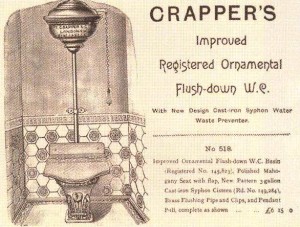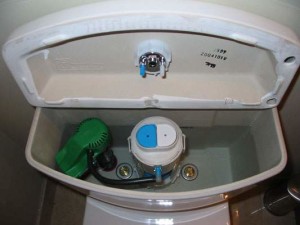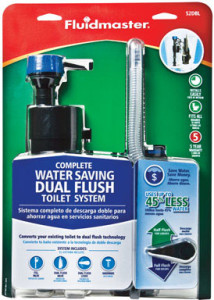by Nick Romaniello
 We have come a long way from digging a hole in the ground, to get rid of our bodily wastes, and then wiping with a leaf — but anyone who has been through a disaster can tell you it doesn’t take much to send us back there. Although toilet technology has progressed over the years, most homes still contain toilets that use components developed in the 18th and 19th century. Karl Benz may find nothing in a modern automobile resembling the horseless carriages that he developed in the late 1800’s, but plumbing pioneer Thomas Crapper could easily find his innovations operating virtually unchanged in commodes over 130 years later. While fancy water saving toilets have become the norm elsewhere in the world, the West has been slow to adopt these due to water being plentiful and cheap. We don’t really stop to think about water consumption very often, but the truth is that the average American family uses about 100 gallons of water per person every day! That’s far more than the one gallon per person per day that we consider the survival standard. The biggest household consumer of water is the toilet, responsible for 25-30% of usage. This can be a heavy burden in a water shortage, or even if you have a finite supply such as a private well or small municipal source. Water conservation can help the planet and your wallet, but it can also preserve a precious resource for more important needs.
We have come a long way from digging a hole in the ground, to get rid of our bodily wastes, and then wiping with a leaf — but anyone who has been through a disaster can tell you it doesn’t take much to send us back there. Although toilet technology has progressed over the years, most homes still contain toilets that use components developed in the 18th and 19th century. Karl Benz may find nothing in a modern automobile resembling the horseless carriages that he developed in the late 1800’s, but plumbing pioneer Thomas Crapper could easily find his innovations operating virtually unchanged in commodes over 130 years later. While fancy water saving toilets have become the norm elsewhere in the world, the West has been slow to adopt these due to water being plentiful and cheap. We don’t really stop to think about water consumption very often, but the truth is that the average American family uses about 100 gallons of water per person every day! That’s far more than the one gallon per person per day that we consider the survival standard. The biggest household consumer of water is the toilet, responsible for 25-30% of usage. This can be a heavy burden in a water shortage, or even if you have a finite supply such as a private well or small municipal source. Water conservation can help the planet and your wallet, but it can also preserve a precious resource for more important needs.
 While new toilets sold in the U.S. meet EPA guidelines of 1.6 gallons per flush, many homes still contain older, less efficient models that can use around six gallons per flush or more. Replacing an old toilet with a new high efficiency model is an easy project for a do-it-yourselfer, but little effort is needed to take it a step further and install a dual flush toilet. Dual flush toilets look like and install like any other toilet but allow you to choose how much water you flush with. Many have two buttons in place of a flush handle or a flush handle that can be pushed up or down to select the desired amount. When you only have urine and some toilet paper to flush, the first setting only uses a fraction of the amount in the tank. For solids, the second setting uses a full tank to thoroughly flush everything down. Gone are the days of the “If it’s yellow let it mellow, if it’s brown flush it down” mentality of conserving water. I have installed many dual flush toilets and my customers have always been pleased with the planet and cash saving technology. Dual flush toilets come in as many style options as any other toilet and like anything, the fancier you want, the more you will pay. However, a dual flush toilet doesn’t have to be expensive. I have installed several Glacier Bay (Home Depot brand) and Aqua Source (Lowes brand) dual flush toilets which cost around $100. I have had no reports of problems with these less expensive models even after some have been in use for years.
While new toilets sold in the U.S. meet EPA guidelines of 1.6 gallons per flush, many homes still contain older, less efficient models that can use around six gallons per flush or more. Replacing an old toilet with a new high efficiency model is an easy project for a do-it-yourselfer, but little effort is needed to take it a step further and install a dual flush toilet. Dual flush toilets look like and install like any other toilet but allow you to choose how much water you flush with. Many have two buttons in place of a flush handle or a flush handle that can be pushed up or down to select the desired amount. When you only have urine and some toilet paper to flush, the first setting only uses a fraction of the amount in the tank. For solids, the second setting uses a full tank to thoroughly flush everything down. Gone are the days of the “If it’s yellow let it mellow, if it’s brown flush it down” mentality of conserving water. I have installed many dual flush toilets and my customers have always been pleased with the planet and cash saving technology. Dual flush toilets come in as many style options as any other toilet and like anything, the fancier you want, the more you will pay. However, a dual flush toilet doesn’t have to be expensive. I have installed several Glacier Bay (Home Depot brand) and Aqua Source (Lowes brand) dual flush toilets which cost around $100. I have had no reports of problems with these less expensive models even after some have been in use for years.
 If you already have a high efficiency toilet that isn’t dual flush, conversion kits are available that replace the flush mechanism in your tank. These conversions are quick, easy and don’t require the removal of the toilet. While the packaging wouldn’t discourage a sale by saying so, these conversion kits do not work on toilets older than 1995 when the low flow technology became the standard. These kits cost from $30 and up.
If you already have a high efficiency toilet that isn’t dual flush, conversion kits are available that replace the flush mechanism in your tank. These conversions are quick, easy and don’t require the removal of the toilet. While the packaging wouldn’t discourage a sale by saying so, these conversion kits do not work on toilets older than 1995 when the low flow technology became the standard. These kits cost from $30 and up.
Upgrading to any dual flush technology will quickly pay for itself with savings on your water bill and keep less of a life giving resource from going down the drain.
